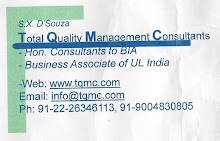ISO 9001 – 2008 Goals and Principles
Author: rusifer
The ISO 9001:2008 revision was released in a digital format on November 14, 2008 and the printed version on November 25th. The revisions are explanatory and editorial in nature. The requirements remain principally intact from the 2000 revision. You can find an in depth review of the changes on our website.
The goals and principles of ISO 9000 still apply. There are eight goals/principles that were initially enumerated in the 2000 release ofISO 9000 that set the temperament and focus of today’s quality management techniques and application.
ISO 9000 addresses process quality standards, not product quality standards. It does not involve inspection to see if a part meets a specification. It addresses examining the process and the controls used during its manufacture. The concept is that if everything in the process is good, it will produce a good product.
The requirements in ISO 9001 do not call for any specific type of product inspection. It does state that if an organization includes product inspection in their production plans they must carry out the inspections as planned.
It’s important that we always keep in mind these goals and principles and focus our efforts on attaining them.
The Eight Goals/Principles of ISO 9000 are:
1) Customer Focused Organization
Take care of the customer first. Companies that focus their energies on customers outperform those that are inwardly focused. Customers don’t reward their suppliers for simply following a procedure. You depend on your customers. You should understand their requirements and expectations and work to exceed them.
2) Leadership
Top management should be leaders. Continual improvement and increased customer satisfaction are attainable when led by top management. Leaders provide direction and make sure everyone is steering the same course.
3) Involvement of people
People make quality a reality. The folks that do the work must know what their customer expects. And, everyone works toward the same goal … the customer’s satisfaction.
4) Process Approach
Plan and setup work the way it naturally flows. When operations and departments work together toward the same goals there is a structure for managing and improving. The whole must be greater than the sum of its parts.
5) System Approach to Management
A company will be more effective if they manage a system of interacting processes. Managing each process as stand alone operations causes conflicts among processes because they work toward individual goals and not what the customer wants.
6) Continual Improvement
Being world class isn’t achieved by accepting the status quo. Small improvements made on an ongoing basis makes world class a reality.
7) Factual Approach to Decision Making
Decisions about change are based on empirical information. Wishing something better doesn’t work. You have heard it before and it’s worth repeating “If you don’t measure it, you can’t manage it”.
![]() Mutually Beneficial Supplier Relationships
Mutually Beneficial Supplier Relationships
Make suppliers partners in your efforts and theirs. You depend on suppliers so you should work toward win-win outcomes. They are the experts in their chosen area and product. Everybody prospers.
Bonus Goal
9) Defect Prevention
Controlling the input to processes through goal # 4 emphasizes the importance of good input resulting in good output. Thereby, theoretically reducing the need to rely on defect detection methods such as inspection. Defect prevention is cheaper than defect detection and correction. In reality the total absence of inspection in manufacturing seems impossible. However, an ongoing endeavor to reduce inspections to a minimum is truly continuous improvement.
Visit : dishwashers ce marking franchising dept 56
source












No comments:
Post a Comment